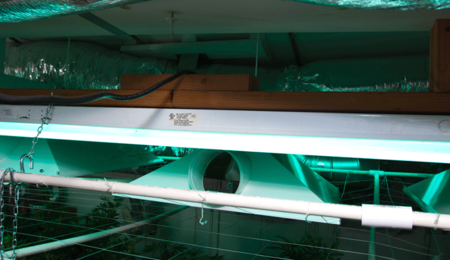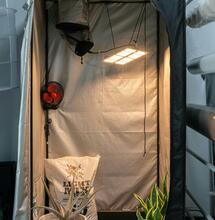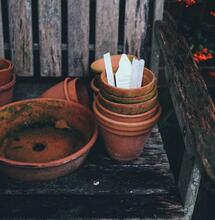Tweaking bud potency using light
01 Oct 2018

People used to think that plants were vegetables; that they have no way of reacting quickly to their environment, and were more like couch potatoes with very slow reactions. There were always signs in clear sight that this isn’t necessarily so. Sunflowers track so they always face the sun. The Venus fly trap closes on its victims the second it’s touched. A fraction of a second after lights are turned on, plants start photosynthesizing. Mimosa pudica, the sensitive plant, collapses its leaves on touch. However, when it is touched repeatedly by the same stimulus, it becomes habituated, and stops reacting. After not stimulating the plant for weeks, it still “remembered” the stimulus and didn’t react. It had ”learned”.
Rhodopsin is a pigment that is very sensitive to light. A version is found in bacteria and it is used in our sophisticated sight system. It’s also found in plants and helps cannabis to regulate its flowering by distinguishing light from dark periods.
[caption id="attachment_8588" align="alignnone" width="800"] This room is illuminated using tanning lamps. Usually they are used 5 hours a day in conjunction with HPS lamps. In this photo the HPS lamps have been turned off for illustrative purposes.[/caption]
Plants also share stress responses with animals regarding UV light. Dark skins have high melanin content to protect against UV light. Light skinned people develop more intense stress reactions and respond to the light by producing melanin, causing tanning, or more severely, sunburn, which actually results in destruction of layers of skin and other destructive reactions.
Plants growing under natural sunlight develop resistance to these harmful UV rays in several ways. They grow longer protective cells (palisade cells) to disperse the light to minimize its intensity and they produce higher levels of pigments, flavonoids and terpenes as sun shields. In various experiments and anecdotal reports THC production increased by 10%. Terpene levels also increase significantly. There are positive effects in other plants, too. For instance, tomatoes grow thicker skins and contain more flavonoids.
[caption id="attachment_8589" align="alignnone" width="800"]
This room is illuminated using tanning lamps. Usually they are used 5 hours a day in conjunction with HPS lamps. In this photo the HPS lamps have been turned off for illustrative purposes.[/caption]
Plants also share stress responses with animals regarding UV light. Dark skins have high melanin content to protect against UV light. Light skinned people develop more intense stress reactions and respond to the light by producing melanin, causing tanning, or more severely, sunburn, which actually results in destruction of layers of skin and other destructive reactions.
Plants growing under natural sunlight develop resistance to these harmful UV rays in several ways. They grow longer protective cells (palisade cells) to disperse the light to minimize its intensity and they produce higher levels of pigments, flavonoids and terpenes as sun shields. In various experiments and anecdotal reports THC production increased by 10%. Terpene levels also increase significantly. There are positive effects in other plants, too. For instance, tomatoes grow thicker skins and contain more flavonoids.
[caption id="attachment_8589" align="alignnone" width="800"] A view of the room showing the 6 foot tanning lamps. [/caption]
[caption id="attachment_8590" align="alignnone" width="800"]
A view of the room showing the 6 foot tanning lamps. [/caption]
[caption id="attachment_8590" align="alignnone" width="800"] A tanning lamp with reflector.[/caption]
When plants grown indoors are placed outdoors in late spring or summer they sometimes get sunburned. Their leaves droop or dry out and they suffer tissue damage. Whether or not they survive and thrive, they are set back. For this reason pants should be gently, gradually introduced to direct sun, perhaps first placed in the shade or by using shade cloth to protect against the sun’s intensity.
You might think that plants in greenhouses are getting full sun. However, most plastics and glass are opaque to UV light. One exception is acrylic sheet, often known by its brand name, “Plexiglas”.
[caption id="attachment_8591" align="alignnone" width="800"]
A tanning lamp with reflector.[/caption]
When plants grown indoors are placed outdoors in late spring or summer they sometimes get sunburned. Their leaves droop or dry out and they suffer tissue damage. Whether or not they survive and thrive, they are set back. For this reason pants should be gently, gradually introduced to direct sun, perhaps first placed in the shade or by using shade cloth to protect against the sun’s intensity.
You might think that plants in greenhouses are getting full sun. However, most plastics and glass are opaque to UV light. One exception is acrylic sheet, often known by its brand name, “Plexiglas”.
[caption id="attachment_8591" align="alignnone" width="800"] On card: Reptile lights can be used to supply UV light.[/caption]
Indoors, fluorescents and HPS lamps produce no UV light. Metal halide lamps often produce small but significant amounts of UV, but the plate glass required for safely enclosing the lamp in the reflector is opaque to it.
Some LED manufacturers include the spectrum in their mixes, but emitters in these spectrums are still costly.
[caption id="attachment_8592" align="alignnone" width="800"]
On card: Reptile lights can be used to supply UV light.[/caption]
Indoors, fluorescents and HPS lamps produce no UV light. Metal halide lamps often produce small but significant amounts of UV, but the plate glass required for safely enclosing the lamp in the reflector is opaque to it.
Some LED manufacturers include the spectrum in their mixes, but emitters in these spectrums are still costly.
[caption id="attachment_8592" align="alignnone" width="800"] Garden of the month – Garden of the MonthR Coral Cove Greenhouse, Jamaica[/caption]
Garden of the month – Garden of the MonthR Coral Cove Greenhouse, Jamaica[/caption]
 This room is illuminated using tanning lamps. Usually they are used 5 hours a day in conjunction with HPS lamps. In this photo the HPS lamps have been turned off for illustrative purposes.[/caption]
Plants also share stress responses with animals regarding UV light. Dark skins have high melanin content to protect against UV light. Light skinned people develop more intense stress reactions and respond to the light by producing melanin, causing tanning, or more severely, sunburn, which actually results in destruction of layers of skin and other destructive reactions.
Plants growing under natural sunlight develop resistance to these harmful UV rays in several ways. They grow longer protective cells (palisade cells) to disperse the light to minimize its intensity and they produce higher levels of pigments, flavonoids and terpenes as sun shields. In various experiments and anecdotal reports THC production increased by 10%. Terpene levels also increase significantly. There are positive effects in other plants, too. For instance, tomatoes grow thicker skins and contain more flavonoids.
[caption id="attachment_8589" align="alignnone" width="800"]
This room is illuminated using tanning lamps. Usually they are used 5 hours a day in conjunction with HPS lamps. In this photo the HPS lamps have been turned off for illustrative purposes.[/caption]
Plants also share stress responses with animals regarding UV light. Dark skins have high melanin content to protect against UV light. Light skinned people develop more intense stress reactions and respond to the light by producing melanin, causing tanning, or more severely, sunburn, which actually results in destruction of layers of skin and other destructive reactions.
Plants growing under natural sunlight develop resistance to these harmful UV rays in several ways. They grow longer protective cells (palisade cells) to disperse the light to minimize its intensity and they produce higher levels of pigments, flavonoids and terpenes as sun shields. In various experiments and anecdotal reports THC production increased by 10%. Terpene levels also increase significantly. There are positive effects in other plants, too. For instance, tomatoes grow thicker skins and contain more flavonoids.
[caption id="attachment_8589" align="alignnone" width="800"] A view of the room showing the 6 foot tanning lamps. [/caption]
[caption id="attachment_8590" align="alignnone" width="800"]
A view of the room showing the 6 foot tanning lamps. [/caption]
[caption id="attachment_8590" align="alignnone" width="800"] A tanning lamp with reflector.[/caption]
When plants grown indoors are placed outdoors in late spring or summer they sometimes get sunburned. Their leaves droop or dry out and they suffer tissue damage. Whether or not they survive and thrive, they are set back. For this reason pants should be gently, gradually introduced to direct sun, perhaps first placed in the shade or by using shade cloth to protect against the sun’s intensity.
You might think that plants in greenhouses are getting full sun. However, most plastics and glass are opaque to UV light. One exception is acrylic sheet, often known by its brand name, “Plexiglas”.
[caption id="attachment_8591" align="alignnone" width="800"]
A tanning lamp with reflector.[/caption]
When plants grown indoors are placed outdoors in late spring or summer they sometimes get sunburned. Their leaves droop or dry out and they suffer tissue damage. Whether or not they survive and thrive, they are set back. For this reason pants should be gently, gradually introduced to direct sun, perhaps first placed in the shade or by using shade cloth to protect against the sun’s intensity.
You might think that plants in greenhouses are getting full sun. However, most plastics and glass are opaque to UV light. One exception is acrylic sheet, often known by its brand name, “Plexiglas”.
[caption id="attachment_8591" align="alignnone" width="800"] On card: Reptile lights can be used to supply UV light.[/caption]
Indoors, fluorescents and HPS lamps produce no UV light. Metal halide lamps often produce small but significant amounts of UV, but the plate glass required for safely enclosing the lamp in the reflector is opaque to it.
Some LED manufacturers include the spectrum in their mixes, but emitters in these spectrums are still costly.
[caption id="attachment_8592" align="alignnone" width="800"]
On card: Reptile lights can be used to supply UV light.[/caption]
Indoors, fluorescents and HPS lamps produce no UV light. Metal halide lamps often produce small but significant amounts of UV, but the plate glass required for safely enclosing the lamp in the reflector is opaque to it.
Some LED manufacturers include the spectrum in their mixes, but emitters in these spectrums are still costly.
[caption id="attachment_8592" align="alignnone" width="800"] Garden of the month – Garden of the MonthR Coral Cove Greenhouse, Jamaica[/caption]
Garden of the month – Garden of the MonthR Coral Cove Greenhouse, Jamaica[/caption]



.png)